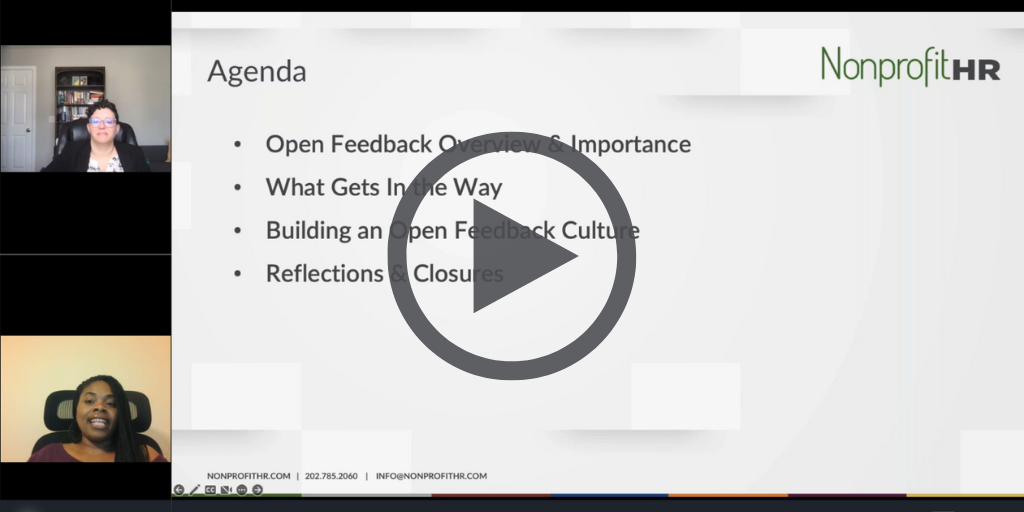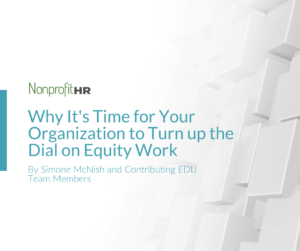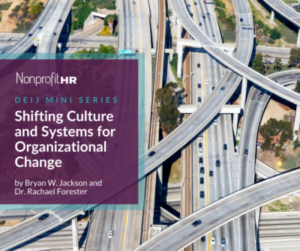WTOP: 5 ways nonprofits can…
A culture of open feedback is a topic that we at Nonprofit HR have always championed in our work. An organization with a culture of open feedback employs immediate, intentional and ongoing conversations with staff, as its leaders work to understand the significance of those conversations and become comfortable engaging in them. Fostering an open feedback culture can result in increased trust, mentoring opportunities and organizational sustainability.
However, in addition to this definition, we would be remiss if we didn’t mention a few more elements critical to the effectiveness of an open feedback culture.
- Psychological safety: If staff do not feel psychologically or professionally safe within their organization, they may be uncomfortable providing feedback — especially to those who manage or supervise them. Without this essential aspect, the feedback that you may receive will neither be the most effective nor the most honest.
- Accountability: Staff feeling comfortable providing feedback is imperative, but they must also know that it is going to be heard and strides will be made by leadership to engage with that feedback.
- Multidirectional dialogue: Feedback should not simply be bidirectional. To cultivate a healthy culture, multidirectional conversations must occur at the one-on-one level between supervisors and supervisees and also among teams and across the organization.
How can organizations establish these processes?
The importance of putting processes around feedback in place is to ensure that staff understand: this is why we are gathering feedback, this is why it is important and this is what we are going to do with it. It doesn’t mean that everyone’s feedback will be implemented but that staff at least know that their feedback is going somewhere beyond just the form they are filling out or the conversation they are having. They know that their voice is being heard in conversations about how they are performing individually or how the organization is faring as a whole.
To ensure feedback is truly multidirectional, we recommend establishing different modalities of feedback when creating collection processes. This includes providing opportunities for introverted and extroverted people to be able to communicate feedback in ways that work best for them. Sometimes people need a chance to process, and if that’s not accounted for, it diminishes their opportunity to contribute. This includes opportunities for feedback to be non-verbal. With this in mind, organizations can employ a variety of channels, such as pulse surveys, one-on-one conversations or staff meetings. Ultimately, open feedback is something that is ongoing and doesn’t have confines as to when, where or how. And once an organization creates processes around feedback collection and what is done with feedback after it has been collected, it should then be made public to employees.
Benefits of a Thriving Open Feedback Culture
“One of the benefits of an open feedback culture is that it increases the expansion of ideas. It increases the potential of the organization and the impact it is able to make. How? By creating a space where all employees feel comfortable sharing their ideas, even if — perhaps especially if — they differ from the status quo.”
- Trust: Trust is built through an effective open feedback culture. The accountability piece is also key here. It is important to collect feedback, but it is equally as important to follow through to continue building trust.
- Inclusion, belonging and retention: When an open feedback culture is working well, when staff are able to share their opinions in an open way without fear of ramifications, it enables them to feel like their views are valued and will be leveraged. This can increase feelings of inclusivity and belonging within an organization. And increased feelings of inclusivity and belonging can result in greater retention and value in their work efforts. Employees in an open feedback culture want to put their best foot forward in the work they do because they know that their thoughts and opinions are truly being heard.
- Mitigation of bias/diversity of thought: One of the ways the EDIJ team defines bias is as it relates to conformity bias or groupthink, which is the idea that we often go along with decisions that are being made by others and we are afraid to push back. This limits the risks that we take as an organization. One of the benefits of an open feedback culture is that it increases the expansion of ideas. It increases the potential of the organization and the impact it is able to make. How? By creating a brave space where all employees feel comfortable sharing their ideas, even if — perhaps especially if — they differ from the status quo. This diversity of thought increases the value of the work being done by ensuring that all perspectives are considered and addressed.
- Ability to apply a critical lens: An open feedback culture provides the organization an opportunity to employ a critical lens in examining what’s working and what’s not working, as well the ability to do this mirror-work within the organization. That means that leadership, or those who are making decisions, are willing to look at the things that they do well and willing to acknowledge the things that they are not doing well. In doing so, and in order to create change, they must be willing to take accountability to create an environment that leads the organization to a place of greater mission impact.
Organizational Elements That Affect the Progress of an Open Feedback Culture
- Stakeholders: Part of adopting an open feedback culture is understanding the different stakeholder groups in the organization and knowing that this feedback is not just an internal process. There has to be accountability for the board and staff where the organization isn’t afraid of change because of how it might impact senior leadership, donors, the board or other stakeholders. An effective open feedback culture will help improve the relationships with internal staff and external stakeholders.
- Environment: Open feedback culture has to look different in different environments. It is critical to consider the environment and the dominant culture of that environment when thinking about how feedback is applied. At Nonprofit HR, we work with a lot of global organizations and giving, receiving and implementing change based on feedback is culturally relevant. Organizations are not in a bubble. Employee cultures, identities, socializations, learnings and backgrounds are brought into an organization, so the organization needs to address those things for that feedback to be possible, let alone effective. In addition, training staff on the organization’s philosophy, structure and process of feedback is essential for getting staff on the same page.
- Identities: Feedback also looks different across generational groups, race, religion and all other dimensions of diversity. Identity impacts how staff at all levels relate and communicate with one another. What’s important for organizations to understand is how that will affect the dynamics for feedback to flow. Consider the complexities of each member of your team, especially in relation to how power operates within our organization.
- Power can play into the success of an open feedback culture because this has to happen across roles, levels and positions. It can’t just be leadership or the people on the ground doing the work. As mentioned, it must go up, across and down. And so, the more hierarchical an organization is, that can sometimes impede an open feedback culture because staff might not feel like they have access and authority to provide feedback to those with more power. Consider the three types of power that may be showing up within your organization.
-
- Positional power: Location within the organization. For example, these powers would lie with the Vice President or CEO roles.
- Referent power: Who you know and how people think of you within the organization. This could also be related to an area of expertise, regardless of level.
- Power from longevity/tenure: How long you have been at the organization and the power that comes as a result.
Normalizing feedback across all levels by giving access to different channels to provide feedback, consistently asking for it from all levels and making it a part of everyday interactions and workflow will help “equalize” the playing field when it comes to feedback.
Takeaways: What Leaders Need to Consider
“Giving feedback simply at semi-annual or annual reviews doesn’t strengthen culture or the employee experience, it just creates a process. A culture of feedback is a living and breathing organism. It is present in everyday interactions among staff and all of their work, not just in those formal processes.”
Co-creation: Within the creation of feedback culture, you need to have different voices and opinions from all levels of the organization. This looks like working groups or focus groups on how to create an open feedback culture. Consider identifying or having managers identify a few staff members that may have thoughts/opinions that differ from what’s already being done within the organization. Creating a space where staff from different levels can come in and talk through what an open feedback culture looks like at the organization and in practice will enable you to create the processes and then how it will look day to day.
Then, having those people share out what that looks like to their different teams is important too. Every organization’s open feedback culture is going to look different because it’s based on the people and the teams that you have. But all employees should be able to articulate how the feedback is going to be taken, what it is going to be used for and how it is being valued within that space.
Part of the co-creation process is also measuring and analyzing the effectiveness of what you’ve created. It’s not just something that is created and is there (a one-and-done approach). It is ever-evolving. It’s something that has to consistently ebb and flow. Once you’ve created and implemented your open feedback culture, ensure those involved in the co-creation are also involved in how it is measured and adapted to continuously fit the needs of your organization.
Acknowledge & model: Leaders must acknowledge that power exists, as well as understand that power is neutral.
They need to then model what this culture of feedback can look like in how they respond in real-time and also how they are showing up, asking for and reacting to feedback as well. An open feedback culture cannot exist if those receiving feedback who ask for it then show up in defensiveness and/or in an inconsistent manner. Those giving feedback must be able to trust that the feedback they are willing to give will be received without resistance and will not be stigmatized or labeled negatively because of it.
Those are things that need to happen to rebuild trust and to create a level or equal playing field because the reality is that it’s not. It’s not an even playing field and the more that we acknowledge that, and the more that those who have power reflect on that power, the better.
Four questions we recommend leaders consider:
- Whose needs are being met?
- Whose needs are not being met?
- Who benefits?
- Who might be harmed?
It is vital to think about these four questions in your open feedback culture, especially as it relates to role, level, department, identity, background and experiences. Identify patterns that are showing up that are negative and establish patterns that are positive and continuously work to make sure you are creating equity within processes. Hierarchy exists, and it can’t be ignored, but there are processes that can be put in place to ensure that there are opportunities to cultivate that open feedback culture.
Transparency: Evening the playing field in terms of power structures will come with time and intentional moments from leadership of valuing when there is a dissent from those power structures. What will help is if leadership is open to hearing that and acknowledging, “This is where we thought we were going but because of the thoughts and opinions we heard, we want to move a different direction.” Being able to intentionally say that and to share what the process looks like transparently of how they make decisions is going to mitigate rigid power structures. Staff are going to feel a lot better about decisions when they can see how they are being made and affect how they are being made.
Professional development: An effective open feedback culture is not just in those intentional moments, like annual reviews, where feedback is being given and received. A culture of feedback is a living and breathing organism. It is present in everyday interactions among staff and all of their work, not just in those formal processes. It is in the day-to-day interactions between staff members. It is in staff member’s ability to approach each other and give feedback.
This is why being able to provide training opportunities on effective communication, for example, is extremely beneficial. Consider also various other EDIJ topics, such as defining microaggressions, how to respond effectively when microaggressions happen, implicit bias, creating transparency and power-sharing as supervisors. These are all things that play a critical role in knowing how to provide feedback.
Lastly, empathy and critical consciousness. Understanding how other people feel but also understanding that our identities or social location impacts how we give feedback and how it is received. Those are things that are critical for organizations to think through. It is about the continuous reflection on self and others, and a lot of that has to do with professional development as it relates to EDIJ training. It’s cyclical.
Continue to ask questions: The most common challenge with open feedback is cultivating that feeling that you are able to share with those that manage or supervise you, that hierarchically have greater power than you within the organization. This is why we recommend also being mindful of the way you present your desire for feedback. Be explicit in communicating how the feedback you are asking for will benefit the individual, other staff members and the organization as a whole.
This includes asking staff how they like to give and receive feedback, including when and where. What would make them feel most comfortable and most valued in the organization?
Continue also to ask questions to understand all the different identities that your team members hold, both spoken and unspoken. Seek to understand those specific identities through different lenses, whether it’s neurodivergence, race, gender, sexual orientation or any other dimension of diversity. Then, take into account all of those things, in relation to self and power, as you co-create and sustain a culture of feedback together.
Contributing Author
 |
Dr. Rachael Forester
Senior Consultant, EDIJ
|


































